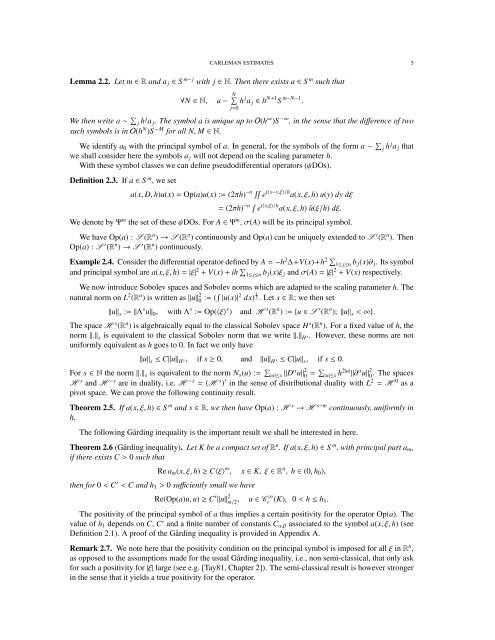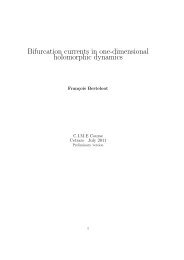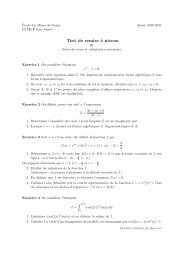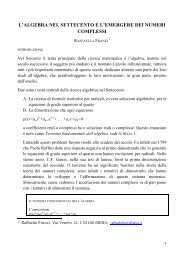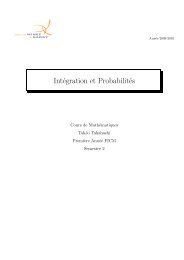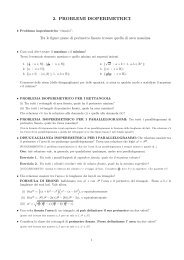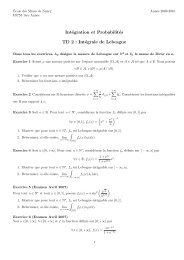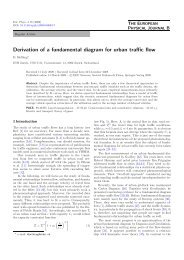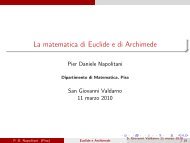on carleman estimates for elliptic and parabolic operators ...
on carleman estimates for elliptic and parabolic operators ...
on carleman estimates for elliptic and parabolic operators ...
You also want an ePaper? Increase the reach of your titles
YUMPU automatically turns print PDFs into web optimized ePapers that Google loves.
CARLEMAN ESTIMATES 5<br />
Lemma 2.2. Let m ∈ R <strong>and</strong> a j ∈ S m− j with j ∈ N. Then there exists a ∈ S m such that<br />
∀N ∈ N,<br />
∑<br />
a − N h j a j ∈ h N+1 S m−N−1 .<br />
j=0<br />
We then write a ∼ ∑ j h j a j . The symbol a is unique up to O(h ∞ )S −∞ , in the sense that the difference of two<br />
such symbols is in O(h N )S −M <strong>for</strong> all N, M ∈ N.<br />
We identify a 0 with the principal symbol of a. In general, <strong>for</strong> the symbols of the <strong>for</strong>m a ∼ ∑ j h j a j that<br />
we shall c<strong>on</strong>sider here the symbols a j will not depend <strong>on</strong> the scaling parameter h.<br />
With these symbol classes we can define pseudodifferential <strong>operators</strong> (ψDOs).<br />
Definiti<strong>on</strong> 2.3. If a ∈ S m , we set<br />
a(x, D, h)u(x) = Op(a)u(x) := (2πh) −n ∫∫ e i〈x−y,ξ〉/h a(x, ξ, h) u(y) dy dξ<br />
= (2πh) −n ∫ e i〈x,ξ〉/h a(x, ξ, h) û(ξ/h) dξ.<br />
We denote by Ψ m the set of these ψDOs. For A ∈ Ψ m , σ(A) will be its principal symbol.<br />
We have Op(a) : S (R n ) → S (R n ) c<strong>on</strong>tinuously <strong>and</strong> Op(a) can be uniquely extended to S ′ (R n ). Then<br />
Op(a) : S ′ (R n ) → S ′ (R n ) c<strong>on</strong>tinuously.<br />
Example 2.4. C<strong>on</strong>sider the differential operator defined by A = −h 2 ∆+V(x)+h 2 ∑ 1≤ j≤n b j (x)∂ j . Its symbol<br />
<strong>and</strong> principal symbol are a(x, ξ, h) = |ξ| 2 + V(x) + ih ∑ 1≤ j≤n b j (x)ξ j <strong>and</strong> σ(A) = |ξ| 2 + V(x) respectively.<br />
We now introduce Sobolev spaces <strong>and</strong> Sobolev norms which are adapted to the scaling parameter h. The<br />
natural norm <strong>on</strong> L 2 (R n ) is written as ‖u‖ 2 0 := ( ∫ |u(x)| 2 dx) 1 2 . Let s ∈ R; we then set<br />
‖u‖ s := ‖Λ s u‖ 0 , with Λ s := Op(〈ξ〉 s ) <strong>and</strong> H s (R n ) := {u ∈ S ′ (R n ); ‖u‖ s < ∞}.<br />
The space H s (R n ) is algebraically equal to the classical Sobolev space H s (R n ). For a fixed value of h, the<br />
norm ‖.‖ s is equivalent to the classical Sobolev norm that we write ‖.‖ H s. However, these norms are not<br />
uni<strong>for</strong>mly equivalent as h goes to 0. In fact we <strong>on</strong>ly have<br />
‖u‖ s ≤ C‖u‖ H s, if s ≥ 0, <strong>and</strong> ‖u‖ H s ≤ C‖u‖ s , if s ≤ 0.<br />
For s ∈ N the norm ‖.‖ s is equivalent to the norm N s (u) := ∑ |α|≤s ‖D α u‖ 2 0 = ∑ |α|≤s h 2|α| ‖∂ α u‖ 2 0 . The spaces<br />
H s <strong>and</strong> H −s are in duality, i.e. H −s = (H s ) ′ in the sense of distributi<strong>on</strong>al duality with L 2 = H 0 as a<br />
pivot space. We can prove the following c<strong>on</strong>tinuity result.<br />
Theorem 2.5. If a(x, ξ, h) ∈ S m <strong>and</strong> s ∈ R, we then have Op(a) : H s → H s−m c<strong>on</strong>tinuously, uni<strong>for</strong>mly in<br />
h.<br />
The following Gårding inequality is the important result we shall be interested in here.<br />
Theorem 2.6 (Gårding inequality). Let K be a compact set of R n . If a(x, ξ, h) ∈ S m , with principal part a m ,<br />
if there exists C > 0 such that<br />
Re a m (x, ξ, h) ≥ C〈ξ〉 m , x ∈ K, ξ ∈ R n , h ∈ (0, h 0 ),<br />
then <strong>for</strong> 0 < C ′ < C <strong>and</strong> h 1 > 0 sufficiently small we have<br />
Re(Op(a)u, u) ≥ C ′ ‖u‖ 2 m/2 ,<br />
u ∈ C ∞<br />
c (K), 0 < h ≤ h 1 .<br />
The positivity of the principal symbol of a thus implies a certain positivity <strong>for</strong> the operator Op(a). The<br />
value of h 1 depends <strong>on</strong> C, C ′ <strong>and</strong> a finite number of c<strong>on</strong>stants C α,β associated to the symbol a(x, ξ, h) (see<br />
Definiti<strong>on</strong> 2.1). A proof of the Gårding inequality is provided in Appendix A.<br />
Remark 2.7. We note here that the positivity c<strong>on</strong>diti<strong>on</strong> <strong>on</strong> the principal symbol is imposed <strong>for</strong> all ξ in R n ,<br />
as opposed to the assumpti<strong>on</strong>s made <strong>for</strong> the usual Gårding inequality, i.e., n<strong>on</strong> semi-classical, that <strong>on</strong>ly ask<br />
<strong>for</strong> such a positivity <strong>for</strong> |ξ| large (see e.g. [Tay81, Chapter 2]). The semi-classical result is however str<strong>on</strong>ger<br />
in the sense that it yields a true positivity <strong>for</strong> the operator.


